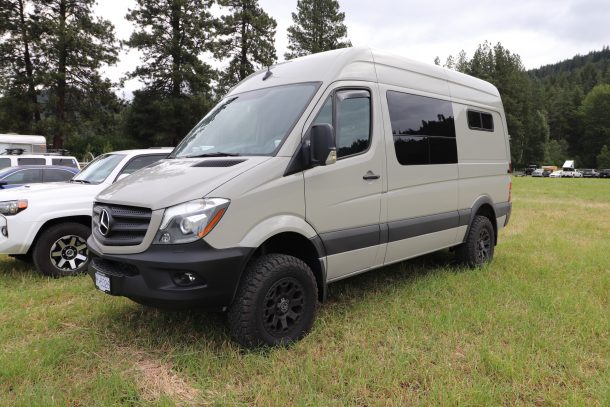Camper Van Deliveries Up 125 Percent in November
Camper vans, ubiquitous homes on wheels for digital nomads, were up 125 percent in total shipments in November, according to the RV Industry Association. This was part of total RV shipments that finished the month with 42,513 units, a 43.4 percent increase over the 29,644 units shipped in November of last year.
“RV manufacturers continue to post impressive shipment numbers as they work to meet the sustained demand for RVs,” said RVIA President Craig Kirby. “Our survey data shows this demand will continue in 2021, with 61 million Americans planning to take an RV trip in the next twelve months.”
Towable RVs, led by travel trailers, totaled 38,485 units for the month, an increase of 46.3 percent compared to last November’s aggregate of 26,297 units. Truck campers, units that slide into pickup beds or mount to flatbed platforms, registered 505 units, up 73.5 percent from 291 the past year.
Motorhomes finished the month with 4,028 units, up 20.3 percent compared to the November 2019 total of 3,347 units. This segment is comprised of Class A, Class B or van campers, and Class C motorized RVs.
Shipments stand at 390,030 units, up 3.0 percent for the year as the RV industry attempts to get a handle on consumer demand. The industry no doubt owes a debt of gratitude to Vice-President Mike Pence, the former governor of Indiana, where most of the RVs in the U.S. are manufactured. Pence quietly lobbied for and won support for the designation of the industry as essential workers, allowing manufacturers to continue largely unimpeded.
Wholesale RV shipments are forecasted to gain nearly 20 percent to 502,582 units in 2021 after totaling 423,628 units in 2020. This projection predicts total shipments ranging between 490,300 and 515,400 units with the most likely 2021 year-end total reaching 502,582, an 18.7 percent increase over 2020. Over the next two months, shipments are anticipated to finish within a range of 414,100 to 433,100 units with the most likely outcome being 423,638 units. That total would represent a 4.3 percent gain over the 406,700 units in 2019.
[Images: © 2020 J. Sakurai/TTAC, RVIA]
With a father who owned a dealership, I literally grew up in the business. After college, I worked for GM, Nissan and Mazda, writing articles for automotive enthusiast magazines as a side gig. I discovered you could make a living selling ad space at Four Wheeler magazine, before I moved on to selling TV for the National Hot Rod Association. After that, I started Roadhouse, a marketing, advertising and PR firm dedicated to the automotive, outdoor/apparel, and entertainment industries. Through the years, I continued writing, shooting, and editing. It keep things interesting.
More by Jason R. Sakurai
Latest Car Reviews
Read moreLatest Product Reviews
Read moreRecent Comments
- Master Baiter Mass adoption of EVs will require:[list=1][*]400 miles of legitimate range at 80 MPH at 100°F with the AC on, or at -10°F with the cabin heated to 72°F. [/*][*]Wide availability of 500+ kW fast chargers that are working and available even on busy holidays, along interstates where people drive on road trips. [/*][*]Wide availability of level 2 chargers at apartments and on-street in urban settings where people park on the street. [/*][*]Comparable purchase price to ICE vehicle. [/*][/list=1]
- Master Baiter Another bro-dozer soon to be terrorizing suburban streets near you...
- Wolfwagen NO. Im not looking to own an EV until:1. Charge times from 25% - 100% are equal to what it takes to fill up an ICE vehicle and 2. until the USA proves we have enough power supply so as not to risk the entire grid going down when millions of people come home from work and plug their vehicles in the middle of a heat wave with feel-like temps over 100.
- Kwik_Shift_Pro4X Where's the mpg?
- Grg These days, it is not only EVs that could be more affordable. All cars are becoming less affordable.When you look at the complexity of ICE cars vs EVs, you cannot help. but wonder if affordability will flip to EVs?






































Comments
Join the conversation
Most people that buy an RV, unless you are going to live in it, let it sit in their driveway or storage for 10/11 months out of the year, then wind up ditching them to the next schmuck who thinks they are going to "see the country" living the good easy frontier life that is portrayed in the advertising!
RV ownership is pricey and it's a luxury unless you do it full time. I don't have a camper right now but have been looking for a small travel trailer. I have borrowed and been camping with others a number of times with my kids and grew up with a 26' travel trailer. I find camping with the kids way less stressful then hotel stays, a lot of that has to do with more places for active kids to roam, in the end it dosen't save any money over vacationing in a hotel but the experience is far different.